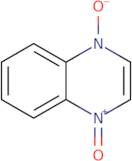
Informations sur le produit
- 1-oxoquinoxalin-1-ium-4(1H)-olate
- BAY-Va 9391
- Bayo N-Ox
- Ccris 1570
- Celbar
- Chindoxin
- Chindoxin [Czech]
- Chinoxalin-1,4-dioxid
- Chinoxalin-1,4-dioxid [Czech]
- Grofas
- Voir d'autres synonymes
- Ici 8173
- Nsc 193508
- Nsc 21653
- Quindoxin [INN:BAN]
- Quindoxina
- Quindoxina [INN-Spanish]
- Quindoxine
- Quindoxine [INN-French]
- Quindoxinum
- Quindoxinum [INN-Latin]
- Quinoxaline 1,4-di-N-oxide
- Quinoxaline 1,4-dioxide
- Quinoxaline N,N-dioxide
- Quinoxaline di-N-oxide
- Quinoxaline dioxide
- Unii-Amx8J6Ys1H
- Usaf H-1
- Quindoxin
- Quindoxin
Quinoxaline-1,4-diium-1,4-bis(olate) is a genotoxic agent that has been shown to cause DNA damage and mutations. In vitro assays have shown that this substance is reactive with human serum in a photochemical reaction, which generates malonic acid and oxidative DNA. It also inhibits bacterial growth by binding to the bacterial 16S ribosomal RNA molecule, thereby inhibiting protein synthesis. This substance has been shown to be active against solid tumours in vivo. The structure of quinoxaline-1,4-diium-1,4-bis(olate) contains a chlorine atom at position 1 and 4 of the aromatic ring system. This chlorine atom can be displaced by an n-oxide group or reduced to form a quinone methide species. These reactions are thought to be responsible for the biological properties of this compound.
Propriétés chimiques
Question d’ordre technique sur : 3D-CAA42366 Quinoxaline-1,4-diium-1,4-bis(olate)
Si vous souhaitez demander un devis ou passer commande, veuillez plutôt ajouter les produits souhaités à votre panier, puis demander un devis ou passer commande à partir de votre panier. C'est une méthode plus rapide, plus économique, et vous pourrez bénéficier des remises disponibles ainsi que d'autres avantages





